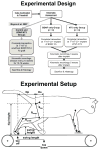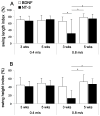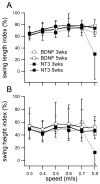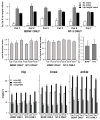Either brain-derived neurotrophic factor or neurotrophin-3 only neurotrophin-producing grafts promote locomotor recovery in untrained spinalized cats
- PMID: 24803493
- PMCID: PMC4223019
- DOI: 10.1177/1545968314532834
Either brain-derived neurotrophic factor or neurotrophin-3 only neurotrophin-producing grafts promote locomotor recovery in untrained spinalized cats
Abstract
Background. Transplants of cellular grafts expressing a combination of 2 neurotrophic factors, brain-derived neurotrophic factor (BDNF) and neurotrophin-3 (NT-3) have been shown to promote and enhance locomotor recovery in untrained spinalized cats. Based on the time course of recovery and the absence of axonal growth through the transplants, we hypothesized that recovery was due to neurotrophin-mediated plasticity within the existing locomotor circuitry of the lumbar cord. Since BDNF and NT-3 have different effects on axonal sprouting and synaptic connectivity/strengthening, it becomes important to ascertain the contribution of each individual neurotrophins to recovery. Objective. We studied whether BDNF or NT-3 only producing cellular grafts would be equally effective at restoring locomotion in untrained spinal cats. Methods. Rat fibroblasts secreting one of the 2 neurotrophins were grafted into the T12 spinal transection site of adult cats. Four cats in each group (BDNF alone or NT-3 alone) were evaluated. Locomotor recovery was tested on a treadmill at 3 and 5 weeks post-transection/grafting. Results. Animals in both groups were capable of plantar weight-bearing stepping at speed up to 0.8 m/s as early as 3 weeks and locomotor capabilities were similar at 3 and 5 weeks for both types of graft. Conclusions. Even without locomotor training, either BDNF or NT-3 only producing grafts promote locomotor recovery in complete spinal animals. More clinically applicable delivery methods need to be developed.
Keywords: kinematics; locomotion; neurotrophin; plasticity; spinal cord injury.
© The Author(s) 2014.
Figures






Similar articles
-
Transplants of Neurotrophin-Producing Autologous Fibroblasts Promote Recovery of Treadmill Stepping in the Acute, Sub-Chronic, and Chronic Spinal Cat.J Neurotrauma. 2017 May 15;34(10):1858-1872. doi: 10.1089/neu.2016.4559. Epub 2016 Dec 20. J Neurotrauma. 2017. PMID: 27829315 Free PMC article.
-
Neurotrophic factors promote and enhance locomotor recovery in untrained spinalized cats.J Neurophysiol. 2007 Oct;98(4):1988-96. doi: 10.1152/jn.00391.2007. Epub 2007 Jul 25. J Neurophysiol. 2007. PMID: 17652412
-
Delayed grafting of BDNF and NT-3 producing fibroblasts into the injured spinal cord stimulates sprouting, partially rescues axotomized red nucleus neurons from loss and atrophy, and provides limited regeneration.Exp Neurol. 2003 Nov;184(1):97-113. doi: 10.1016/s0014-4886(03)00394-7. Exp Neurol. 2003. PMID: 14637084
-
Transplants and neurotrophic factors increase regeneration and recovery of function after spinal cord injury.Prog Brain Res. 2002;137:257-73. doi: 10.1016/s0079-6123(02)37020-1. Prog Brain Res. 2002. PMID: 12440372 Review.
-
The "beneficial" effects of locomotor training after various types of spinal lesions in cats and rats.Prog Brain Res. 2015;218:173-98. doi: 10.1016/bs.pbr.2014.12.009. Epub 2015 Mar 29. Prog Brain Res. 2015. PMID: 25890137 Review.
Cited by
-
Adaptation to slope in locomotor-trained spinal cats with intact and self-reinnervated lateral gastrocnemius and soleus muscles.J Neurophysiol. 2020 Jan 1;123(1):70-89. doi: 10.1152/jn.00018.2019. Epub 2019 Nov 6. J Neurophysiol. 2020. PMID: 31693435 Free PMC article.
-
Delayed viral vector mediated delivery of neurotrophin-3 improves skilled hindlimb function and stability after thoracic contusion.Exp Neurol. 2023 Feb;360:114278. doi: 10.1016/j.expneurol.2022.114278. Epub 2022 Nov 28. Exp Neurol. 2023. PMID: 36455639 Free PMC article.
-
Transplants of Neurotrophin-Producing Autologous Fibroblasts Promote Recovery of Treadmill Stepping in the Acute, Sub-Chronic, and Chronic Spinal Cat.J Neurotrauma. 2017 May 15;34(10):1858-1872. doi: 10.1089/neu.2016.4559. Epub 2016 Dec 20. J Neurotrauma. 2017. PMID: 27829315 Free PMC article.
-
Exercise-Induced Plasticity in Signaling Pathways Involved in Motor Recovery after Spinal Cord Injury.Int J Mol Sci. 2021 May 4;22(9):4858. doi: 10.3390/ijms22094858. Int J Mol Sci. 2021. PMID: 34064332 Free PMC article. Review.
-
Intrathecal Delivery of BDNF Into the Lumbar Cistern Re-Engages Locomotor Stepping After Spinal Cord Injury.IEEE Trans Neural Syst Rehabil Eng. 2020 Nov;28(11):2459-2467. doi: 10.1109/TNSRE.2020.3027393. Epub 2020 Nov 6. IEEE Trans Neural Syst Rehabil Eng. 2020. PMID: 32986558 Free PMC article.
References
-
- Boyce VS, Tumolo M, Fischer I, Murray M, Lemay MA. Neurotrophic factors promote and enhance locomotor recovery in untrained spinalized cats. J Neurophysiol. 2007 Oct;98(4):1988–96. - PubMed
-
- Jakeman LB, Wei P, Guan Z, Stokes BT. Brain-derived neurotrophic factor stimulates hindlimb stepping and sprouting of cholinergic fibers after spinal cord injury. Exp Neurol. 1998 Nov;154(1):170–84. - PubMed
-
- Barbeau H, Rossignol S. Recovery of locomotion after chronic spinalization in the adult cat. Brain Res. 1987 May 26;412(1):84–95. - PubMed
-
- Belanger M, Drew T, Provencher J, Rossignol S. A comparison of treadmill locomotion in adult cats before and after spinal transection. J Neurophysiol. 1996;76(1):471–91. - PubMed
Publication types
MeSH terms
Substances
Grants and funding
LinkOut - more resources
Full Text Sources
Other Literature Sources
Medical
Research Materials
Miscellaneous

